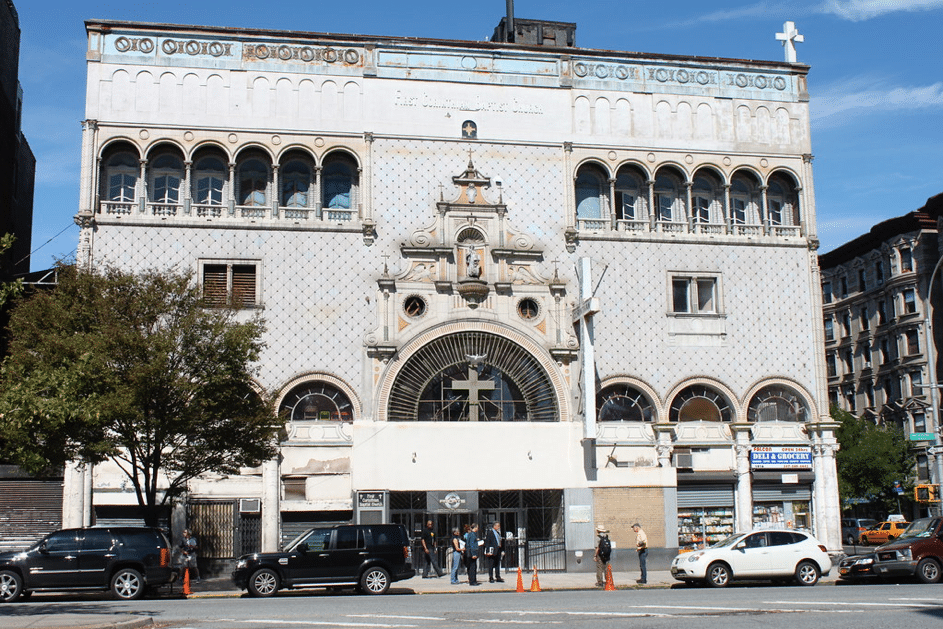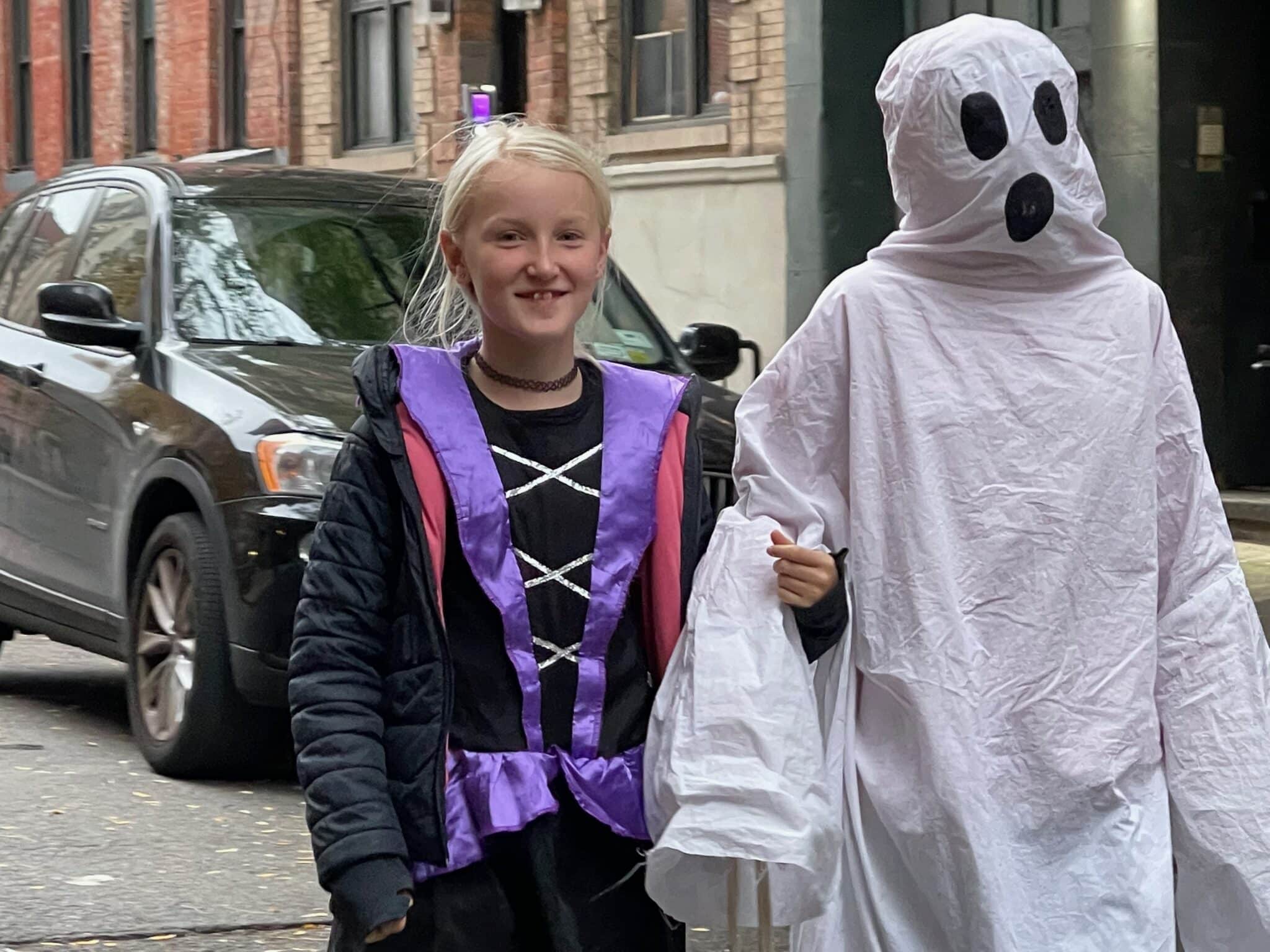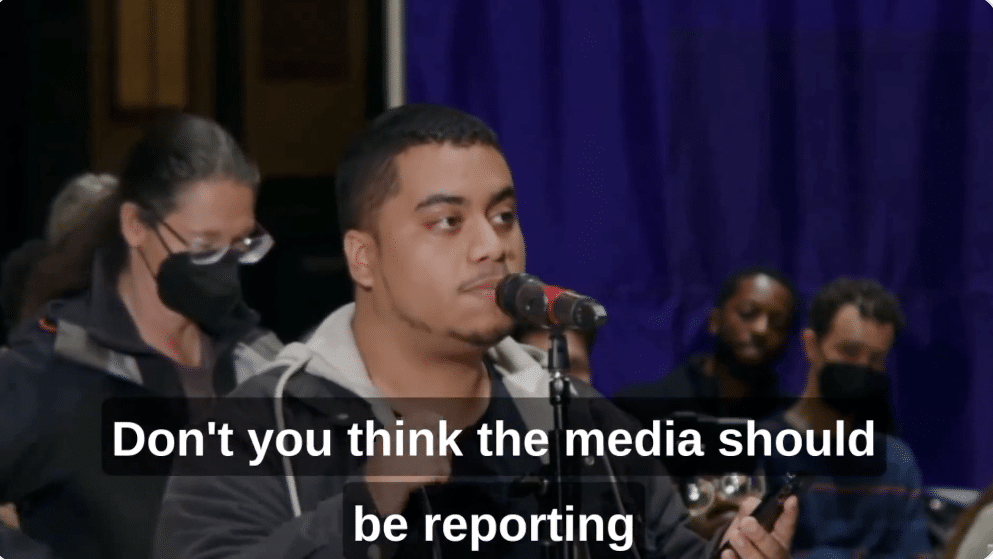First Corinthian Baptist Church Harlem. Photo by Marie-Soizec Fabroulet
NEW YORK – Giant screens on both sides of the stage counted down the minutes before the start of the early Sunday service at Harlem’s First Corinthian Baptist Church (FCBC). In the front rows, church members in their Sunday best greeted each other with warm embraces. A different crowd, a few dozen jeans-wearing tourists, settled into the back rows and the balcony and waited for the show.
The clock hit zero and a small choir on the stage led the congregation in singing the first hymns. Then Pastor Kyndra Frazier opened her arms and said, “First time comers, stand! Let’s give them a round of applause.” And the tourists, the largest part of the audience, obliged.
Tourists from across the country and around the world are flocking to Harlem’s churches for Sunday morning services. Sometimes they outnumber the local parishioners. Many of the visitors we interviewed told us they got the idea to attend churches in Harlem from guidebooks like the famous French guide Le Routard.
French tourist Marylène Bonnay said, “It was written down as a must-have experience in our Routard because, you know, it’s widely known that gospel choir is part of the American culture and part of the Harlem myth.” But guides aren’t the only things that drive tourists to Harlem churches. Websites including New York City’s official site, NYCGO, promote Sunday gospel in Harlem. Guided tours also bring groups to Harlem’s churches and then sometimes take tourists to soul food brunches. In 2012, Harlem churches were reported ‘getting sick’ of the tourists.
But at the First Corinthian Baptist Church, many appreciate them. Church Communications Director John Lesley Morton said, “The church is even busier and with more tourists for the second service at 10:45. We sometimes have around 300 tourists.” In some ways, the church seems to have grown and organized the service and the gospel spectacle that goes with it for the tourists. For some, it helps to fill smaller congregations. Others see it as a good marketing opportunity. Generally, as long as the visitors are respectful, local parishioners seem to agree that faith is opened to all. The woman welcoming and regulars and tourists at First Corinthian’s front door said, “God isn’t ours to share among ourselves. If they want to worship Him with us, then that’s alright.”
The gospel music the tourists come to hear finds its roots in the black oral tradition. After emancipation, when African-Americans formed their own churches, it became part of their identity. “We wanted to experience this for the music and for the atmosphere!” said Margaux Cossart, another French visitor.
Some church members appreciate that. Gerome Kelly said, “Most of them have never heard gospel music before. So yeah, they come to hear gospel music. And you know what? They hear gospel music and they’re happy and that’s that.” He went on, “I think they come, not because they want to pray to God, but because they want to see the way it is we pray, we worship and they expect a show.”
But others get upset. “I mean sometimes the fact that they’re coming as spectators…they don’t actively participate and it’s like, listen, this isn’t a Broadway show or anything,” one man said. Italian tourist Alice Alessandro noticed the same thing. She said, “I didn’t personally feel awkward or not welcomed but I did feel weird to be among a group of gawky white tourists who weren’t dancing or singing or participating in the Call-and-Response hymns.”
Some tourists just didn’t respond to the religious part of the service and we spotted them leaving half-way through or dozing during the sermon. French traveller Jean-Claude Lepetit said, “The sermon was too long. I don’t speak English and could not follow what was being said so I almost fell asleep. I didn’t sing either, I just didn’t understand the lyrics.” An elderly tourist disagreed, “If services in France were more like this, more people would attend them.”
Other tourists found the hard sell of the church off-putting. Alice Alessandro said, “The sermon was very good but other than that, I was surprised by the way that church seemed to shape its experience for the tourists. There was even a video, that lasted at least fifteen minutes, that explained the sixteen ways you can donate money to the church. I thought that was a bit too much since it’s supposed to be a place of worship. I mean, yes, donations are important but it shouldn’t be the goal of the service, right? It’s great that they’ll finance good projects for the neighborhood, for the kids, the poor or the elderly…but…it was still surprising and strange to me.”
Overall, most of the tourists and parishioners left happy. As she left the church, Margaux Cossart said, “We weren’t disappointed. It’s so joyful and the atmosphere is just great. That’s what we’ll remember from this experience.”
When it was over, they walked out armed with backpacks and cameras and headed into the streets of Harlem, ready for a full day of sight-seeing. They could be heard asking around in front of the church, “So what’s there to see in Harlem? What would you recommend?” Others flipped through the pages of their guidebooks for the next must-do activity. Parishioner Gerome Kelly pointed to a group of French people that seemed headed to 125th Street and said, “I bet you they’ll stop by the Apollo because it’s the birthplace of jazz, or whatever. It’s good that Harlem is recognized as having economic potential but…damn…maybe soon it’ll stop feeling authentic to us.”
Tags: Alice Alessandro First Corinthian Baptist Churc French Tourists Harlem Gerome Kelly Gospel Music Harlem Churches Jean-Claude Lepetit John Lesley Morton Le Routard Margaux Cossart Marie-Soizic Fraboulet NYCGO Pastor Kyndra Frazier






